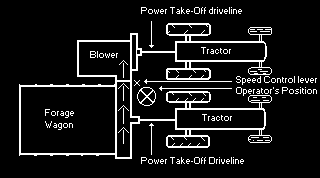NIOSH Warns Farmers of Forage Wagon Hazards
September 14, 1995
NIOSH Update:
Contact: Fred Blosser (202) 260-8519
- Working with forage wagons can be extremely dangerous and may cause severe injury, amputation, or death.
- Installing an extension to increase the space between the tractors and ensuring that PTO drivelines are properly guarded will significantly reduce the risk of injury.
According to the National Institute for Occupational Safety and Health (NIOSH), farmers who use forage wagons are at risk for severe injury, amputation, or death. NIOSH recently published an article in the Centers for Disease Control and Prevention's Morbidity and Mortality Weekly Report (MMWR) detailing the hazards associated with forage wagons and outlining prevention measures.
The agriculture industry is one of the most dangerous in the country and working with farming equipment can be extremely hazardous. However, the hazards associated with forage wagons are not widely recognized. Forage wagons are used to transport and unload feed into storage or feed areas. They are typically used on farms that raise large animals and grow their own feed. The following case describes hazards associated with forage wagon use.
On October 1, 1993, a farmer was using a forage wagon to unload corn silage into a silo blower. To unload the silage, the farmer used a tractor to pull his forage wagon next to his silo blower, which was attached to another tractor. To reach the speed control lever on the forage wagon, he stepped over the running power take-off (PTO) driveline which connected his tractor to the wagon. As he stepped, his pants became entangled around the unprotected PTO driveline. The victim suffered severe injuries, including amputation of the genitalia and deep tissue damage to the buttocks requiring hospitalization and extensive grafting. He was hospitalized for two weeks and unable to work for one month. The farmer's total medical costs to date, are $79,000, of which he must pay $9,000. He anticipates possible additional surgery at an unknown cost.
"These are tragic injuries," said NIOSH Director, Dr. Linda Rosenstock. "We must ensure that the farming community and equipment manufacturers and dealers are aware of the hazards and know how to prevent them." The following page details additional cases and provides relatively simple and inexpensive measures to prevent other injuries from occurring. NIOSH requests your assistance in informing the farming community of this problem and the steps for prevention.
Additional Cases
In October 1994, a 19-year-old farmer sustained fatal massive internal injuries after stepping too close to the unguarded PTO driveline while unloading silage.
In November 1992, a 9-year-old girl lost both of her legs above the knees when her jacket became entangled in the unguarded rotating PTO driveline she was reaching over to operate the forage wagon speed control.
In September 1991, a 33-year-old farmer was working between two drivelines on a windy day. He suffered multiple fractures to his leg and lost his right foot when his shirt blew into an unguarded revolving PTO driveline.
In October 1992, a 41-year-old farm operator sustained an avulsion of the entire scrotal area when his pant leg became entangled as he stepped over the unguarded PTO driveline on his forage wagon.
What Are the Hazards?
The injuries described here are caused by a combination of factors. It is well known that unguarded PTOs may cause severe entanglement injuries. Additionally, in order to unload silage, the forage wagon, silo blower, and both tractors must be close to one another. The speed-control lever for the forage wagon is often located between the wagon and the blower. Because of the size of the equipment, there is usually not room to walk between the tractors to operate the forage wagon controls. Consequently, the operator often steps over the revolving PTO driveline which may lead to injury or even death.

Typical arrangement of equipment used to transfer feed from a forage wagon into a blower
Steps for Prevention
- Equip PTO drivelines with proper, functioning guards.
- Avoid stepping over rotating PTO drivelines.
- Pre-set the mechanical speed control device on the wagon to allow unloading without leaving the tractor seat.
- Install a conveyor extension to forage wagons to increase the walking space between the two tractors. The extension will also increase efficiency.
- Manufacturers should promote other speed controls such as hydraulic kits that permit operating the wagon from an alternate location.
- Shut off PTO drivelines whenever possible before dismounting tractors.
- Do not wear loose or bulky clothing around PTO drivelines.
- Keep bystanders - especially children - away from PTO-driven equipment.
- Recognize that farm equipment is designed for operation by adults.
- Avoid working alone when using hazardous equipment. In the cases described here all of the survivors were rescued by the quick response of persons nearby.
- These cases were identified by the Occupational Health Nurses in Agricultural Communities (OHNAC) Program. The OHNAC program is part of the NIOSH Agricultural Health and Safety Initiative which supports surveillance, research, and intervention efforts for farming communities.
- For a copy of the MMWR article, Injuries Associated with Self-Unloading Forage Wagons, or for information on other workplace concerns call toll free: 1-800-35-NIOSH
- Page last reviewed: July 22, 2015
- Page last updated: September 14, 1995
- Content source:
- National Institute for Occupational Safety and Health Education and Information Division


 ShareCompartir
ShareCompartir